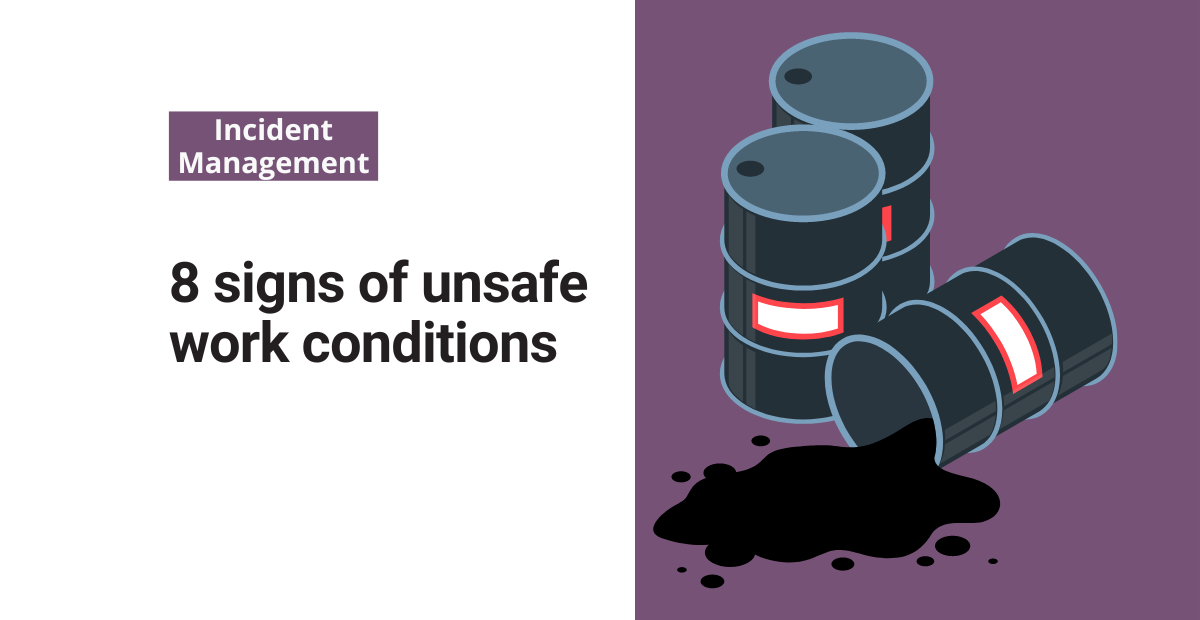According to the Bureau of Labor Statistics, “private industry employers reported 2.6 million nonfatal workplace injuries and illnesses in 2021.” And this figure doesn’t even account for the fatalities that occur each year due to unsafe work conditions. This demonstrates the severity of workplace hazards.
Being able to quickly recognize workplace hazards is an essential skill for incident prevention. Luckily, you can train yourself to spot dangerous situations linked to unsafe work environments. By recognizing these situations on the spot makes it easier to avoid an injury or fatality altogether, especially in unsafe work conditions.
Here are 8 signs of unsafe work conditions that you should be able to recognize. Therefore, commit them to memory and expand your ability to find and address hazards right away.
Free template!
Want to get your workers involved? Consider conducting a safety culture survey using this template. This can be part of your strategy to identify work situations that could be unsafe, highlighting potential unsafe conditions.
Dangerous and unsafe work conditions
Some unsafe conditions are more obvious than others. Hopefully, you can use these general signs to dig deeper. This will help you get to the heart of any kind of unsafe conditions.
Messy workstations
One of the most obvious—yet somehow most rampant—unsafe working conditions is a messy workspace. Having a lack of organization immediately increases incident risk, which contributes to unsafe work conditions. Therefore, avoid this at all costs. Luckily, disorganization is one of the more straightforward issues to solve, although it may require some trial and error to settle on the best setup.
Missing safety guards
OSHA’s machine guarding standard exists for a reason—unguarded equipment provides a serious hazard to workers. Missing safety components are the hallmark of an unsafe work environment. Consequently, if the facility does not protect workers from its most dangerous equipment, how many smaller hazards do they encounter throughout the day as well?
Excessive clutter makes unsafe work conditions
Clutter creates trip and fall hazards, blocks emergency exits, and can even cause fire hazards (among others). Therefore, a lack of personal accountability for workplace safety is a type of hazard that you often overlook. Arguably, this is one of the biggest safety concerns that arise from unsafe work scenarios.
Broken tools or equipment
Broken equipment is a major hazard in and of itself. When workers attempt to use faulty tools, they can hurt themselves. Additionally, they can create more unsafe conditions for their coworkers, which leads to unsafe work conditions.
Noticeable rusting
Equipment and/or structural components with excessive rusting pose a potential safety threat to your workers and customers. Corrosion control is an essential practice for ensuring the longevity of machinery and in addressing unsafe conditions effectively.
Dress code violations
Therefore, a lack of personal accountability for workplace safety is a type of hazard that you often overlook. Failing to adhere to grooming and dress code standards can actually create work conditions that are unsafe. These conditions contribute to unsafe work environments, affecting the entire team and not just the individual.
Modified equipment
Making modifications to process equipment is risky without the proper approach. If you notice any makeshift or modified equipment, chances are that there’s a safety incident waiting to happen due to unsafe conditions.
Frequent process incidents
Identifying patterns is the key to unlocking incident root causes. If you notice that a high percentage of incidents come from a specific process, it may be a sign of dangerous working conditions. These conditions point to underlying unsafe work practices.
Document your observations for unsafe work conditions
You cannot be everywhere at once, so it is unrealistic to expect that you can stop all workplace injuries from happening. However, when you walk the floor and address any unsafe work conditions right away, you inadvertently teach your workers to do the same.
Keeping an eye out for these signs means you have a better chance of protecting workers. You protect them not only from dangerous equipment and processes but possibly their own behaviors as well. This constant vigilance is crucial for preventing unsafe conditions.
Take your incident prevention strategy to the next level by upgrading to EHS corrective action software. This kind of software solution allows you to create action items for the unsafe work conditions that you come across.
It gives you the ability to assign owners and deadlines to corrective actions. This helps to ensure they’re completed in a timely manner.




